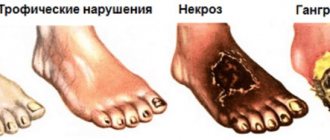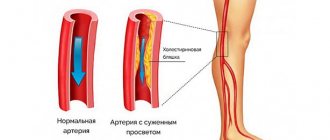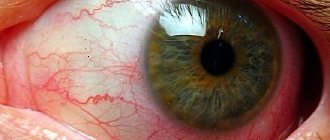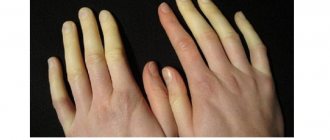What is lymphangitis? This is an inflammation of the lymphatic vessels, which can occur for various reasons. Its appearance is accompanied by a number of characteristic symptoms.
No one is immune from this disease, and therefore we will now talk about why it can arise, what signs can actually be used to identify it, as well as how diagnosis is carried out and treatment is carried out.
Manifestation of the disease
To begin with, it’s worth talking in a little more detail about what lymphangitis is. This is a chronic or acute inflammation of the lymphatic capillaries or trunks, which occurs secondary. It is always preceded by a purulent-inflammatory process.
This phenomenon is accompanied by swelling along the inflamed vessels, which is noticeable to the naked eye. Swelling is also possible. Lymphadenitis, an inflammation of the lymph nodes of a purulent nature, often develops.
It is important to note that with this disease, completely different vessels located at any depth can be affected. As a rule, inflammation is concentrated on the extremities, and this is logical - after all, they are injured most often.
You should consult a doctor as soon as you notice mild manifestations of lymphangitis, the photo of which shows a truly unpleasant sight. If a person begins to progress with this disease, it means that the primary pathology is progressing.
What is lymphangitis
Lymphangitis is an inflammation of blood vessels that occurs in people of any age.
More often it affects the lower extremities (legs), forearms of the hands. Men whose work is associated with increased trauma are often observed.
The disease is secondary. First, microbes enter the superficial sections of the lymphatic capillaries.
Then, with the outflow of tissue fluid, large vessels penetrate into the lumen of the lymphatic capillary.
The infection begins to release toxic compounds and the formation of protein fibrin with a fibrous structure, which glues the walls of the vessel, impairs the patency, causing stagnation of the lymph.
An inflammatory process in blood vessels that occurs without pus is usually called serous. The infection spreads quickly, affecting the lymphatic vessels and subcutaneous fat. This causes suppuration, provokes the transition of the disease into a purulent form with a sharp deterioration in the well-being of patients.
Etiology
Many people know that the lymphatic system is a complex vascular structure. When pathogenic bacteria and viruses enter the body, immune cells are produced in the lymph, which become a barrier to them and also cleanse the blood.
If this protection does not exist (the reason is severe infection and weakened immunity), then this “barrier” does not arise.
As a result, bacteria from the purulent focus enter the interstitial space. And from there - into the lymphatic system. As a result, the endothelium of small vessels is affected and inflammation occurs. First, reticular lymphangitis forms, and then stem lymphangitis.
Cancerous lymphangitis
Cancerous lymphangitis occurs due to metastasis of cancer cells from malignant foci into lung tissue.
This disease manifests itself as shortness of breath and the development of signs of cor pulmonale.
With cancerous lymphangitis, respiratory failure is severe and the blood picture changes quickly; tests show anemia.
An X-ray determines the damage to the root zones, lower and middle pulmonary fields.
With lymphangitis, the apexes of the lungs are never affected, and this is an important distinguishing feature of the disease from other pulmonary pathologies.
Causes
As mentioned earlier, lymphangitis (ICD-10 - I89.1) develops secondarily. The prerequisite is a deep or superficial purulent-inflammatory focus. In general, the reasons can be identified as follows:
- Infected wound or abrasion.
- Phlegmon.
- Carbuncle.
- Abscess.
- Furuncle.
- Staphylococcus aureus.
- Proteus.
- Beta-hemolytic streptococcus.
- Escherichia coli.
If we talk about pathogens, they are the following pathogens:
It is important to note that specific lymphangitis usually occurs in patients who have had tuberculosis.
Forms
In medicine, several classifications of lymphangitis are used. Depending on the nature of the inflammation, lymphangitis can be:
- Serous.
- Purulent.
According to severity, lymphangitis is divided into:
- Spicy.
- Chronic.
Depending on the depth of development of the inflammatory reaction, lymphangitis can be:
- Deep.
- Superficial.
Depending on the size of the inflamed vessels, lymphangitis is defined as:
- Reticular (reticular). With this form of the disease, many small vessels located superficially are involved in the inflammatory process. Their inflammation manifests itself as redness and therefore causes a mesh-like pattern to appear on the skin.
- Stem (truncular). The inflammatory reaction spreads to one or several large-sized stem vessels.
Lymphangitis is also divided into types:
- Non-venereal lymphangitis occurs due to stagnation of lymph in the tissues of the penis.
- Specific lymphangitis is associated with tuberculosis, syphilis or urogenital infections.
- Cancerous lymphangitis occurs as a complication of malignant lung disease.
- Carcinomatous lymphangitis appears in breast cancer in women and lung cancer in people of both sexes.
Symptoms
There are several signs by which you can determine the presence of lymphangitis. The symptoms are as follows:
Over time, symptoms worsen. Sharp pain is observed, lymphedema begins to develop, some areas transform into an abscess or phlegmon. If they are not opened, sepsis may develop.
Symptoms and signs
Most often, lymphangitis progresses with injuries to the extremities, since it is on the arms and legs that the largest number of microbes are found
The clinical picture directly depends on the size of the vessels that were affected. When the pathological process affects small capillaries, it appears on the skin in the form of small red stripes that go from the site of inflammation to the local lymph nodes. When palpating the affected area, a thickening is clearly felt, as if there is a cord running under the red stripe.
When the cause of inflammation of the lymphatic vessels is a boil or a festering wound, redness without clear boundaries is observed around it. Acute lymphangitis is accompanied by pronounced local manifestations and intoxication.
The following general symptoms are identified:
- feverish conditions, chills;
- weakness, the patient complains of poor general health;
- increased body temperature;
- headache;
- increased sweating;
- limited limb movements;
- numbness of the tongue.
A blood test in the acute form indicates an excess of leukocytes.
There are also a number of local symptoms that more clearly indicate lymphangitis:
- the skin around the wound site turns red and swells, the redness does not have clearly defined boundaries;
- the site of swelling becomes hot to the touch;
- characteristic red lines spread across the skin of the limb;
- a vascular network appears at the site of the lesion;
- when pressing on the red lines or during friction, a pressing pain is felt along the entire length of the inflamed vessel;
- the patient feels throbbing pain in the affected limb;
- the skin becomes rough and dries;
- Local lymph nodes enlarge.
If we talk about the chronic form of lymphangitis, then, in addition to the above symptoms, the following manifestations are also observed:
- vasospasm;
- expansion of infected areas;
- stagnant blood processes and slow blood flow;
- swelling of the infected limb.
In some cases, the functioning of the organ near which the inflamed vessel passes is also disrupted. This is how lymphangitis of the lungs occurs, for example.
If the lymphadenitis is deep, then there may be no redness on the skin. Only painful sensations appear when pressing on the areas where the pathological process occurs.
Diagnostics
Lymphangitis of the lower extremities or any other parts of the body can be determined by a specialist during a visual examination. The difficulty lies in only one thing - the disease must be differentiated from superficial phlebitis and erysipelas. And here identifying the inflammatory focus helps.
It will be difficult to detect deep lymphangitis. What it is? This is the name of a disease in which pronounced leukocytosis can be detected in the peripheral blood. That is why it is necessary to submit this biological fluid for analysis.
In addition, the lymphologist must take into account the results of laboratory and instrumental studies and clinical and anamnestic data.
The patient is also referred to undergo the following diagnostic procedures:
All this helps to determine changes in the lymphatic vessels, narrowing of the lumen, the depth and severity of lymphangitis, as well as determine which microorganism was the causative agent.
Treatment of pleural mesothelioma
Only 10% of cases of pleural mesothelioma can be treated surgically. After such a procedure, patients survive to the 2-year mark only in 10-35% of cases. As for radiation therapy used to relieve pain, it does not affect overall survival.
To suppress mesothelioma, the following cytostatics are used: anthracyclines, gemcitabine. Their use is more or less effective in 30-48% of cases. A decent result is achieved with combined use (for example, gemcitabine + cisplatin, Alimta + cisplatin).
Today, a combination of new cytostatics or alternate use with targeted medications is considered potentially effective. When making a prognosis, special attention is paid to the age of the patients (the younger the person, the greater the chance of a favorable outcome), the epithelial type of tumor formation, and the degree of effectiveness of adjuvant chemotherapy carried out after radical pleuropneumoectomy.
To select an effective treatment method, you can contact
— methods of innovative therapy; — opportunities to participate in experimental therapy; — how to get a quota for free treatment at the oncology center; - organizational matters.
After consultation, the patient is assigned a day and time of arrival for treatment, a therapy department, and, if possible, an attending doctor is assigned.
Principles of treatment
So, based on all of the above, you can understand what lymphangitis is. This is a serious disease, and it is better not to delay its treatment.
The first step is to eliminate the primary focus, which maintains inflammation in the lymphatic vessels. To do this, the doctor treats infected wounds, opens phlegmons, panaritiums, abscesses, after which he drains and sanitizes them.
The affected limb is then fixed in a slightly elevated position. The person will have to maintain motor rest.
Many people do not immediately consult a doctor and prefer to treat themselves. So, you can’t do this! The following actions are also strictly prohibited before opening (and after):
Drug treatment is indicated, but it is prescribed only by a lymphologist, and only after examining the patient.
Treatment of lymphangitis
Treatment of lymphangitis is aimed at eliminating the primary focus that provoked the occurrence of the inflammatory process in the lymphatic vessels. To do this:
- treatment of existing wounds;
- opening, drainage and sanitation of felons, abscesses, phlegmons.
You cannot massage, heat inflamed tissues or rub ointments into them. It is important to provide the patient with complete motor rest.
Medications indicated:
- Antibacterial drugs (first and second generation cephalosporins, semisynthetic penicillins, lincosamides, aminoglycosides can achieve the best effect).
- Antihistamines.
- Anti-inflammatory complexes.
Physiotherapeutic procedures can include:
- laser blood irradiation (ILBI);
- ultraviolet blood irradiation (UFOI).
Surgical treatment is performed only if it is necessary to drain the abscess.
Treatment of chronic lymphangitis
In case of a sluggish chronic course of the disease, the patient is prescribed:
- semi-alcohol compresses;
- local ointment dressings;
- X-ray therapy;
- mud therapy;
- compresses with dimethyl sulfoxide;
- Ural Federal District.
Specific treatment for non-venereal lymphangitis of the penis is usually not carried out. If the pathology is caused by a sexually transmitted infection, the underlying disease is treated.
Drug therapy
Now we can talk about the treatment of lymphangitis. After the actions described above have been completed, a rehabilitation period begins, during which the person must take a course of medications. He may be assigned:
The patient may also be recommended to undergo ultraviolet or laser irradiation. These procedures significantly speed up the healing process and also improve the overall condition.
Lymphangitis in adults
Inflammation itself occurs due to the entry of pathogenic microorganisms into the body. Most often, lymphadenitis is caused by bacteria:
- Staphylococcus aureus;
- streptococcus;
- protea;
- coli.
Bacteria accompany a person throughout his life, so a healthy body is able to block them. For the development of lymphangitis, in addition to the penetration of microbes into the human body, it also requires the presence of some pathogenic factors:
- Injuries, skin damage, the presence of purulent inflammations (boils, carbuncles, abscesses).
- Acute and chronic infections of various organs.
- Reduced immunity, immunodeficiency, including acquired - AIDS.
When treating, it is necessary to get rid of not only inflammation in the lymphatic system, but also the reasons that caused it.
Although lymphangitis occurs in adults only when the surface of the skin is damaged, which can occur in both men and women, sometimes this disease becomes a purely male disease. Non-venereal lymphangitis is inflammation of the lymphatic capillaries in the penis as a result of frequent and prolonged sex and masturbation.
Abrasions and abrasions form on the surface, through which the infection penetrates to the coronary sulcus. The affected area first swells, and then goes away after a few days without any treatment. However, in rare cases, it turns out that a sexually transmitted infection has penetrated the genital organ, which develops a corresponding venereal disease.
Chronic and persistent course
These are special cases. To cure a patient facing chronic or persistent lymphangitis of the extremities (or other part of the body), the following is prescribed:
Also a special case is venereal infectious lymphangitis. This is a serious case, but the treatment here is simple - it is aimed at eliminating STDs.
What medications the venereologist will prescribe depends on the pathogen. Some medications help in the fight against gonorrhea, but other medications will be needed to treat syphilis - everything is very individual.
How to treat lymphangitis
Treatment of lymphangitis is complex and is carried out only as prescribed by a doctor. Initially, the doctor must establish the root cause of the disease and carry out the rehabilitation of human infectious diseases. It is important to understand that in order to cure lymphangitis, you need to eliminate the underlying disease.
In addition, the patient is prescribed a number of medications and procedures that will help relieve general symptoms, improve the patient’s general condition and prevent complications.
- Broad-spectrum antibiotics. Preference is given to cephalosporins (Cefotaxime, Cefazolin, Ceftriaxone) or macrolides (Sumamed, Azithromycin, Erythromycin). Taking antibiotics will suppress and destroy the bacterial flora and eliminate complications.
- Antihistamines. Tavegil and Suprastin relieve inflammation and swelling of tissues.
- NSAIDs. Eliminate inflammation and pain with Ibuprofen and Nimesil.
Treatment also includes other medications that are administered intravenously or intramuscularly in a hospital setting. The dose of any drug and the treatment course are determined by the doctor individually for each patient.
The following will help speed up the healing process:
- detoxification treatment;
- physiotherapeutic procedures;
- mud therapy.
Traditional medicine, which has many recipes in its arsenal, is an auxiliary therapy to the main treatment. Traditional treatment for lymphangitis includes the use of herbal decoctions and infusions of chamomile, St. John's wort or calendula.
If the disease is diagnosed in time and measures are taken, the prognosis is favorable, but if treatment is absent or carried out incorrectly, the disease progresses and provokes complications.
Lymphangitis of non-venereal origin, in which damage to the penis occurs, does not require treatment. Therapy is aimed only at eliminating the main source of infection.
Non-venereal lymphangitis of the penis
This disease deserves separate consideration. It usually affects the vessels around the coronary sulcus or along the trunk of the organ. Most men who encountered this problem had:
Specific symptoms include the following:
Non-venereal lymphangitis of the penis is treated in the same ways as inflammation that occurs in another part of the body. However, in this case there are specific recommendations.
To prevent inflammation from occurring in such an intimate place, you need to avoid any injuries to the penis and prolonged masturbation. You need to adhere to a measured sex life, as well as maintain hygiene.
Causes of lymphangitis
The cause of acute lymphangitis is various inflammatory foci (furuncle, panaritium, abscess, phlegmon), superficial infections of the skin and mucous membranes, as well as infected and granulating wounds, ulcers, etc. The main role in infections is played by staphylococci and streptococci. There are also other pathogens, however, in more rare cases.
The inflammatory process covers the wall of the lymphatic vessel. Swelling, increased permeability and release of exudate occur, followed by leukocyte infiltration along the vessel (perilymphangitis). Due to lymph coagulation, which is facilitated by swelling and desquamation of the endothelium, blood clots form in the vicinity of the valves (thrombolymphangitis).
Thrombi of lymphatic vessels consist of endothelial cells, leukocytes and bacteria. Thrombosis causes lymph stagnation. In some places, blood clots can undergo triple melting and, spreading through the vessel wall destroyed by necrosis, cause the appearance of lymphangitic abscesses in the neighborhood. The most severe form of lymphangitis is the purulent form.
Lymphangitis of the lungs
This is a specific, special inflammation that can become cancerous. With this disease, metastases spread through the lymphatic vessels of the lungs. In these cases, the primary cancer occurs in the pancreas, breast, colon, or stomach.
The following symptoms are observed:
Often a person is treated unsuccessfully for sore throat and bronchitis, since the symptoms are similar. But here an X-ray examination is necessary. It is this that allows you to notice the transformation of the pulmonary pattern, as well as other changes.
You must make an appointment for an x-ray immediately. It is better to make mistakes in assumptions than to allow the lymph nodes to enlarge to such a size that they begin to appear on the tomogram.
Clinical picture and forms of the disease
The intensity of the symptoms depends on the form of the disease, but in any case the disease has a pronounced clinical picture, which manifests itself against the background of severe intoxication of the body. Lymphangitis - the photo above will allow you to see what the disease looks like. Common signs of the disease include:
- increased body temperature up to 39.5-40°C;
- fever;
- weakness;
- fatigue;
- headache;
- general malaise.
Epizootic, regional, acute and reticular lymphangitis are manifested by the following symptoms:
- superficial hyperemia at the site of inflammation;
- erythema at the site of inflammation;
- burning sensation in the affected area.
In the reticular form, there is erysipelas of the skin without boundaries of hyperemia.
The regional form of the disease often leads to local complications, in which pathogenic microbes from the vessels penetrate into the lymphatic system, causing lymphadenitis. Lymphangitis and lymphadenitis are two interrelated diseases with severe damage not only to the vessels of the lymphatic system, but also to the lymph nodes.
If a patient is diagnosed with stem lymphangitis, there are red stripes on the skin along the large vessels, as well as swelling and tenderness of the lymph nodes on palpation.
Purulent forms of the disease are severe, especially if the patient has a history of diabetes, alcoholism or cachexia. Acute forms include perilymphangitis, which is a complication and often provokes the development of abscesses, and the lack of timely treatment can lead to sepsis.
Non-venereal lymphangitis is accompanied by a painful lump along the penis, but treatment is not always required. In some cases, enlarged vessels disappear without a trace after 3 days.
A dangerous type of disease is considered to be cancerous and carcinomatous lymphangitis. They develop more often in women against the background of breast cancer. Cancerous lymphangitis is always accompanied by enlarged lymph nodes and often metastasizes to other organs and systems. The chronic form of the disease has less pronounced symptoms, but the disease often relapses, which significantly worsens the patient’s general well-being. When examining a patient with a history of “lymphangitis,” the doctor, upon palpation, discovers painful cord-shaped seals along the affected vessel. If there is deep vascular damage, there may be no redness on the skin.
Folk remedies
They can be used during the rehabilitation period only after permission from a doctor. The following tools are popular:
These are good remedies, and with their help you can strengthen your immune system, but they are not a replacement for drug treatment. We must remember this.
Lymphangitis - causes, symptoms, prevention in Nizhny Novgorod
Lymphangitis is an inflammation of the capillaries and lymphatic trunks, which develops against the background of purulent-inflammatory processes. The disease is accompanied by swelling, pain and hyperemia along the inflamed lymphatic vessels, weakness, and increased body temperature.
Pathology can affect vessels of different locations and sizes. Most often in their practice, phlebologists and lymphologists encounter lymphangitis of the lower extremities. This is explained by the nature of local lymph circulation, frequent microtrauma and the presence of a fairly large number of microbial pathogens.
Slightly less frequently diagnosed:
- lymphangitis of the lungs;
- non-venereal lymphangitis of the penis;
- specific venereal lymphangitis;
- lymphangitis of the mammary gland, etc.
The disease is characterized by symptoms of secondary lymphadenitis.
Forms of lymphangitis
Based on the nature and severity of the developed inflammatory process, the following are distinguished:
- serous, or simple, lymphangitis;
- purulent lymphangitis.
According to the depth of the vessels:
According to the clinical course, it happens:
- acute lymphangitis;
- chronic lymphangitis.
Taking into account the caliber of inflamed lymphatic vessels, the disease is classified into:
- capillary (mesh, reticular) – the surfaces of a large number of lymphatic capillaries are involved in the inflammatory process,
- stem (truncular) – one or more large lymphatic vessels are inflamed.
Causes of lymphangitis
Lymphangitis is a secondary infection. It always occurs due to the patient’s existing superficial or deep purulent-inflammatory foci. This refers to boils, carbuncles, abscesses, wounds, phlegmon.
Among the main pathogens:
- beta-hemolytic streptococcus;
- Staphylococcus aureus;
- Proteus;
- coli;
- other aerobic flora in associations or as a monoculture.
Specific lymphangitis is caused by tuberculosis.
The causes of lymphangitis of the lower extremities are:
- microtraumas;
- abrasions;
- trophic ulcers;
- scratching;
- panaritiums.
Non-venereal lymphangitis of the penis is a consequence of trauma to the tissues of the organ during prolonged sexual intercourse and frequent masturbation.
Specific venereal lymphangitis develops as a result of diseases caused by sexually transmitted infections:
- genital herpes;
- primary syphilis;
- urethritis.
Pathogenesis
The risk of developing an inflammatory process depends on:
- location and size of the primary infectious focus;
- features of lymph circulation in the anatomical zone;
- virulence of microflora.
Microbial agents, together with toxins, enter the interstitial space from the source of inflammation. Afterwards they penetrate the lymphatic capillaries and, together with the lymph flow, move to large lymph nodes and vessels.
Signs of reactive inflammation of the vascular wall are:
- endothelial swelling;
- increased permeability;
- loss of fibrin clots;
- development of exudation;
- formation of blood clots inside blood vessels.
These processes cause a disorder of local lymph circulation (lymphostasis). In the absence of proper treatment, the disease may progress to a purulent form.
If inflammation spreads to surrounding tissues, the doctor diagnoses perilymphangitis, which leads to damage to joints, blood vessels, and muscles. Together with the blood flow, the pathological process can spread all the way to the thoracic lymphatic duct.
Symptoms of lymphangitis
Common symptoms of lymphangitis include:
- intoxication accompanying the inflammatory (purulent) process;
- high body temperature (39-40°C);
- chills;
- hyperhidrosis;
- headache;
- weakness.
Reticular ( capillary ) lymphangitis always begins with superficial hyperemia around the infectious focus (wound), an increase in the mesh pattern against the background of erythema. According to clinical signs, this form of the disease resembles erysipelas. The main difference is that hyperemia has vague boundaries, which is not observed with erysipelas.
Stem lymphangitis is characterized by red stripes on the skin along the inflamed lymphatic vessels leading to the regional lymph nodes. At the same time, swelling develops, edema forms, and dense and painful to the touch cords appear.
In the case of a deep form, hyperemia does not occur, but edema increases very quickly, and lymphedema develops almost immediately. With perilymphangitis, the tissue surrounding the inflamed area can transform into an abscess or subfascial phlegmon. Untimely opening of the lesion is fraught with sepsis.
Chronic lymphangitis does not have acute symptoms and is characterized only by the presence of persistent edema, the formation of which is caused by blockage of deep lymphatic trunks. Non-venereal lymphangitis of the penis is manifested by the appearance of a compacted cord along the coronary groove or shaft (it goes away on its own within a few days).
If you notice similar symptoms, consult a doctor immediately. It is easier to prevent a disease than to deal with the consequences.
Diagnosis of lymphangitis
A lymphologist can diagnose regional lymphangitis during a routine visual examination. In this case, the disease must be differentiated from superficial phlebitis and erysipelas, which can only be done through laboratory and instrumental studies.
Diagnostic signs of lymphangitis:
- pronounced leukocytosis in peripheral blood;
- duplex scanning and ultrasound doppler scanning reveal changes in the lymphatic vessels according to the type of heterogeneity of structure, narrowing of the lumen, reticular changes in the lymph nodes;
- during computed tomography, it is possible to determine the depth and extent of lymphangitis, to distinguish the disease from other pathologies that have similar symptoms;
- Bacteriological culture of a detachable purulent wound makes it possible to identify the pathogen.
In case of a complicated form of the disease, a blood test for sterility is required.
Treatment of lymphangitis
Treatment of lymphangitis is aimed at eliminating the primary focus that provoked the occurrence of the inflammatory process in the lymphatic vessels.
To do this:
You cannot massage, heat inflamed tissues or rub ointments into them. It is important to provide the patient with complete motor rest.
Medications indicated:
- Antibacterial drugs (first and second generation cephalosporins, semisynthetic penicillins, lincosamides, aminoglycosides can achieve the best effect).
- Antihistamines.
- Anti-inflammatory complexes.
Physiotherapeutic procedures can include:
- laser blood irradiation (ILBI);
- ultraviolet blood irradiation (UFOI).
Surgical treatment is performed only if it is necessary to drain the abscess.
Treatment of chronic lymphangitis
In case of a sluggish chronic course of the disease, the patient is prescribed:
- semi-alcohol compresses;
- local ointment dressings;
- X-ray therapy;
- mud therapy;
- compresses with dimethyl sulfoxide;
- Ural Federal District.
Specific treatment for non-venereal lymphangitis of the penis is usually not carried out. If the pathology is caused by a sexually transmitted infection, the underlying disease is treated.
Why is lymphangitis dangerous?
Long-term lymphangitis can lead to:
- lymph circulation disorder (the qualitative composition of lymph changes, its quantity increases significantly);
- obliteration of lymphatic vessels (the lumen of the vessel becomes overgrown);
- development of elephantiasis (skin and subcutaneous tissue thicken due to chronic inflammation of the lymphatic vessels), lymphostasis (tissue swelling resulting from impaired lymph outflow);
- abscess (purulent inflammation of tissues with their melting, which leads to the formation of a purulent cavity);
- sepsis (a systemic inflammatory reaction diagnosed as a result of infectious agents entering the blood);
- cellulite (changes in the structure of the subcutaneous fat layer, which lead to disturbances in lymphatic outflow and lymph circulation).
Prevention
Prevention of acute lymphangitis consists of:
- high-quality and timely treatment of wounds;
- rehabilitation of pustular diseases;
- taking vitamin and mineral complexes;
- observing the rules of personal hygiene.
Secondary prevention of lymphangitis consists of opening the resulting purulent foci and taking antibacterial drugs prescribed by a doctor.
Source: https://nn.MedCentr.online/library/letter/l/illness/limfangit
Complications
If a person does not ignore the symptoms and begins treatment on time, the disease can be eliminated without consequences. Otherwise, he will suffer from complications, including:
And these complications, in turn, are fraught with serious consequences. Lyphedema, for example, is almost always eliminated surgically - the vessels are crossed, followed by coagulation of the central ends and the creation of anastomoses.
And a circulatory disorder is even fraught with blood leaving the vessels and changing its volume.
This is why it is important to immediately seek help from a doctor. Once neglected, an untreated infection can lead to very serious consequences that are dangerous to health and life.
Diagnosis of lymphangitis
If a primary lesion is present, the diagnosis is easy to establish. Only the diagnosis of deep lymphangitis presents certain difficulties, but in the presence of a main inflammatory focus, characteristic pain spreading from it along the lymphatic tract, and an early reaction of regional lymph nodes, establishing this diagnosis does not present any particular difficulties.
Differential diagnosis
Differential diagnosis for lymphangitis is carried out with erysipelas and thrombophlebitis. In the first case, the sharp limitation of the focus characteristic of erysipelas and the sudden onset of the disease help establish the correct diagnosis. In the second case, ultrasound angioscanning comes to the rescue, making it possible to detect pathology of the subcutaneous and deep veins of the extremities.
Prevention
Well, about this one last time. The main preventive measure is a timely visit to the doctor if soft tissue suppuration occurs, as well as completing the treatment of the infectious disease. There is no need to quit therapy just because you “already feel better.”
You should also not create additional obstacles to lymphatic drainage. Crossing your legs when sitting, for example, or carrying a heavy bag on your arm.
It is also necessary to maintain hygiene, dress warmly and avoid stress. And, of course, it is advisable to undergo a general examination regularly.
It is better to identify the disease at an early stage than to treat the advanced stage later. This always brings a considerable amount of trouble, takes a huge amount of time, nerves and money.
Prognosis and prevention
Timely administration of treatment for the acute form of the disease quickly leads to complete recovery. The chronic form of the disease takes much longer to treat and often leads to complications.
In order to prevent the development of lymphangitis, it is enough to properly treat the smallest scratches on the body and pay sufficient attention to personal hygiene. If signs characteristic of this disease appear, you should consult a doctor as soon as possible. The disease is treated mainly by surgeons.
Why is lymphangitis dangerous?
Long-term lymphangitis can lead to:
- lymph circulation disorder (the qualitative composition of lymph changes, its quantity increases significantly);
- obliteration of lymphatic vessels (the lumen of the vessel becomes overgrown);
- development of elephantiasis (skin and subcutaneous tissue thicken due to chronic inflammation of the lymphatic vessels), lymphostasis (tissue swelling resulting from impaired lymph outflow);
- abscess (purulent inflammation of tissues with their melting, which leads to the formation of a purulent cavity);
- sepsis (a systemic inflammatory reaction diagnosed as a result of infectious agents entering the blood);
- cellulite (changes in the structure of the subcutaneous fat layer, which lead to disturbances in lymphatic outflow and lymph circulation).
Lymphangitis in children
Lymphangitis often develops in children. Children are more active and less careful in their movements. It is very easy to get hurt, hurt or seriously injured. Bacteria that constantly live on the skin easily penetrate inside, causing an inflammatory process, and then suppuration, which together provokes inflammation of the lymphatic capillaries and blood vessels. It is very important to treat wounds in a timely manner. If they suppurate, treat in a hospital to prevent the development of lymphangitis.
Why does lymphangitis develop?
Lymphangitis is an infectious lesion of the walls of deep and superficial lymphatic vessels, the cause of which is most often the intervention of Staphylococcus aureus - a formidable bacterium that constantly mutates and causes many serious diseases of the skin, lungs, heart, and joints.
Staphylococcus aureus.
Colonies of Staphylococcus aureus live on the skin without causing harm to humans, but if the integrity of its integument is damaged through cuts or abrasions, they penetrate into the blood and are carried by current throughout all organs and systems.
Due to the activation of immune mechanisms, slight inflammation around the wound goes away after a few days, sometimes even without special treatment.
However, in some cases, the activity of the infection is not sufficiently suppressed by the body due to the amazing ability of staphylococcus to adapt to the most unfavorable conditions for it and a temporary weakening of the immune system.
The entry points for infection are wounds, abrasions, ingrown nails, boils - in general, any foci in which suppuration develops.










